by Marion Patterson | Apr 25, 2019 | (Sub)Urban Homesteading, Children/Play, Garden/Yard, Garden/Yard, Nature
-
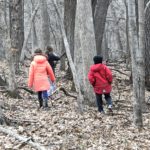
-
Kids take to the woods.
-
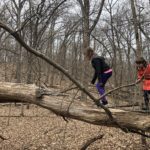
-
Starting off carefully.
-
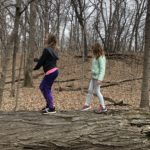
-
Walking confidently.
Kid Adventure
Nature reduces stress. We saw it in action at Winding Pathways on an early April Sunday morning.
About 15 kids from the Faith Formation Group of Peoples Church Unitarian Universalist visited. Most were five to ten years old. After collecting eggs and scattering treats for the hens, we took them to Faulke’s Heritage Woods. It’s a 110-acre woodland protected from development by a conservation easement held by the Iowa Natural Heritage Foundation.
It wasn’t a guided walk. It was a kid adventure. As we distantly watched, the kids scampered into the oaks where they discovered a huge fallen tree spanning a ravine. A natural bridge. They couldn’t resist making the crossing and then raced from fallen log to fallen log, traversing each. Laughter entertained the many standing trees as the kids were enveloped in nature, inventing games and having fun. No constructed playground in a city park or schoolyard matches the wonder and fun of ponds, prairies, and tiny streams.
-
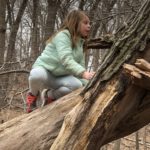
-
Careful calculations
-
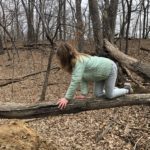
-
Learning to navigate a log.
-
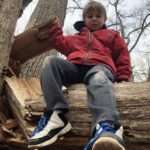
-
Exploring the log
Lots of research has been conducted on nature’s ability to relieve stress in both adults and children. Experts call time spent in beautiful places the nature pill and even 20 minutes spent walking in the woods reduces stress.
Everyone Benefits
Mary Carol Hunter recently completed a nature pill study and said, “Our study shows that for the greatest payoff, in terms of efficiently lowering levels of the stress hormone cortisol, you should spend 20 to 30 minutes sitting or walking in a place that provides you with a sense of nature.”
We’re lucky to have Faulke’s Woods adjacent to Winding Pathways, but most of our time outdoors is spent close to our home on our own property. Often, it’s simply sitting in the yard enjoying a cup of coffee as we watch chickadees flit around.
Hunter’s words, “sense of nature” are powerful. Although visits to national and state parks, wildlife refuges, and nature preserves are wonderful stress relievers, anyone’s yard or balcony can do the same. We created Winding Pathways several years ago to encourage people to enjoy their yard, even if that’s a tiny apartment balcony in a big city. Structuring the yard or balcony to create natural beauty attracts interesting wildlife while giving people easy and free access to the “nature pill.”
Go outside and have fun, just like the kids did in Faulke’s Woods.
by Marion Patterson | Dec 20, 2018 | Children/Play
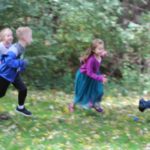
Kids get creative outside
“Let’s play outside!” For baby boomers, that was something we said and did every day. Driving slowly through neighborhoods was a must in those days because the yards and streets were literally full of kids. We played outside after school and on weekends, 365 days a year. Every day was a “play date.” No need for mom or dad to arrange one.
In today’s world, you can drive for miles through town and not see a single child. What changed? Three main factors are frequently cited as the reasons for this retreat from outdoors to indoors:
- High profile child abductions in the 80s and 90s.
- Video gaming and screen time.
- Organized sports and activities.
In the 80s and 90s, there was a handful of child abductions that became a part of the 24-hour news cycles, such as the Jacob Wetterling case. They gave parents the impression that these abductions were becoming more frequent, even epidemic So parents became reluctant to let their kids play outside. We now know, however, that for decades the number of stranger abductions of children has remained unchanged, according to readily available statistics, such as those from the Office of Juvenile Justice and Delinquency Prevention.
Video gaming and screen time are obvious to us all. When we do see kids in public, their noses are glued to their phones.
Organized sports and activities are great for keeping kids busy and healthy, and, at least for a short time, away from their phones. But there is a negative side. Kids and parents are overscheduled, driving from school to sports/lessons to fast food to more sports/lessons. Stress and burn out are among the many negative results.
So, what can be gained by having kids go outside and play?
-

-
Solving the problem of squirrels raiding the feeder.
-
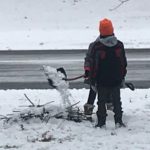
-
Henry adds to his squirrel-proof wall.
- Development of creativity. Kids have to be imaginative to come up with their own games and play outside. A fallen tree becomes an airplane flying to China. A pile of snow becomes a fort. A rope tied between trees becomes a bridge over burning lava.
- The more the merrier and playing outside means kids learn, by trial and error, how to be friends, share ideas, solve problems and resolve conflict.
- Discovery and appreciation of the environment. Kids learn best through experience and an iPad doesn’t come close to helping a child learn about the outdoors like living in it does.
- Attention span. The Wiley Online Library reports that studies show that green outdoor spaces reduce ADHD symptoms in children.
How can we get our kids to play outside? We can’t just open the door and tell them to go outside and play. In two minutes, they’ll be coming back in saying they’re bored and want to do their screens and games.
So, here’s how to start:
- Go outside and play with them. Get them an idea (making a stick fort, playing touch football) and get them started. After a while, leave them to it and go back inside.
- Limit screen time. If they know they only have 30 minutes per day of screen time (phone, iPad, TV) and they’ve already burned that up, that eliminates the desire for screen time instead of playing outside.
- Let them get dirty and tell them it’s perfectly OK to do so.
- Give them tools for playing. A rope, an old bucket, a frisbee, a glider, a jar. Be creative yourself!
- Invite neighborhood friends over. The more the merrier.
- Let them use the hose on a hot day. Give them a watering can and have them “water the trees.”
- Don’t let the weather stop outside play. We live in the Upper Midwest and we know how to dress for cold weather. Playing outside in winter is a blast for kids, and it leads to things like hot chocolate and hot baths – which mean more socialization, family time and less screen time.
- Teach your kids “new” games – the kind we used to play all the time outside: Kick the can, tug of rope, flashlight tag, frozen tag.
- Set a limit. Not a maximum limit, a minimum. It was the other way around when we were kids. We’d head out to play on a Saturday and mom would say to be back before dark. (I’m not making this up). But for kids who are learning how to play on their own outside, try setting the minimum time – thirty minutes or so to start. They’ll come back to the door after five minutes saying they don’t know what to do. Send ‘em back out and let them know that only they can solve that problem. And guess what? They will!
-
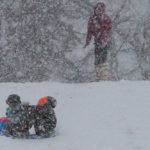
-
Go outside and play with the kids for a while.
-

-
Kids can learn to exuberantly embrace the outdoors.
-
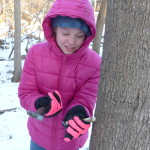
-
Savannah taps a homemade spile into a backyard maple.
Kids’ imaginations are powerful and given the chance, they will use them to create their own outside adventures. Pretty soon you may just find yourself yelling out the door that it’s time to come in for dinner and hearing, “Aw, Mom!! Just five more minutes!”
by Winding Pathways | Mar 26, 2018 | Birds, Children/Play, Nature
“Something Going On in that Tree”
Guest Blog by Wahneta Dimmer
Todd and I sat at the breakfast table – coffee for me and a coca cola for him – looking out the sliding glass doors at the backyard and out into the park beyond. As he half read the newspaper Todd said, “Hey, look in the tree, there is a big bird sitting on that lower branch.” It took me a minute to find the object he was focusing on but sure enough, there in the early morning light, sat a large bird shadowed by snow-covered branches. We are accustomed to having many small birds visit our feeders throughout the winter but to see a predatory bird is rare. And so low and close to the house, seemingly eyeing the park for prey, is exceptional! We watched for a while before going on about our morning.
Both the kids were spending their third day home from school, recovering from a winter virus, not too sick to stay in bed but just miserable enough to lay low. Kael was standing at the same sliding glass doors when he excitedly exclaimed, “There is a fight or something going on in that tree, Mom.” I told him about the large bird his dad and I had seen earlier in the morning. As we watched, snow was flying out of the upper branches and cascading downward. Kael imagined the bird duking it out with a squirrel! Suddenly, the bird dropped from the tree and flopped into the snow. I said to Kael that it looked like a red-tailed hawk. He wasn’t sure he agreed but we thought we should investigate.
Reconnaissance, Research and Rescue
We both hastily bundled up and headed out across the backyard. As we approached the landing zone, the bird jumped away dragging a wing with him. Kael and I agreed on two things: positively a red-tailed hawk and clearly, injured. Knowing any attempt to get closer would exhaust its remaining reserves, we retreated to the house and called for backup. Kael researched online what to do with an injured raptor and settled on the RARE program. According to their website, the program focuses on rescue, triage and long term medical treatment of injured, sick and distressed raptors. Todd and the kids asked for advice on how to gently capture the bird and safely transfer it to the Iowa City facility. They settled on a wool blanket and dog carrier and as the best options.
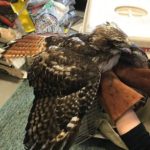
Injured Hawk
True to February in Iowa, it was sunny and brisk with temperatures in the mid 30s and a breeze that made you think is was much cooler. Todd, Kael and Ava headed out into the park just after lunch to relocate the missing, injured raptor. The guys went to the right toward the ball diamond while Ava intuitively chose to head out the gate to the left. Within minutes, Ava located the injured hawk resting at the base of a crab apple tree. She called the guys over, and taking the advice of the RARE associate, they got just close enough to toss the wool blanket gently over the hawk and then Todd scooped him up! The poor bird was so cold and tired, he didn’t even fuss when they put him in the dog carrier, covered him up again and closed the door. As they drove to Iowa City, they wondered aloud what had happened to it and whether it would recover.
Rehabilitation
When they arrived at RARE, rehabilitator, Nikki Herbst, greeted them, assessed the newest arrival, determining it probably was a male hawk, and told them about what the rehab center does. She even introduced them to some of the permanent residents, those too injured to be released into the wild. “Miss Nikki” wasn’t too optimistic as she assessed the hawk. It seemed too weak to stand on its own, much less eat.

Ava Rare Champion Hawk Award
She was kind enough to award the kids with a RARE Wildlife Champion Award and thanked them for their service. Her parting words were, “No news is good news,” meaning she would only call us if he died. If he were to be released, it would be done with discretion at the same place that the bird was found.
Release
Five weeks later, much to our surprise, we received a joyous call from “Miss Nikki.” She was eager to share the news that our hawk rescue was successful, and he was ready to be released. She wondered if we would like to participate?! She went on to say that he was back to his feisty self and flying around the indoor enclosure as high to the ceiling as he could. He was completely recovered from his injury, a broken femur! We agreed on a time with the place predetermined, the park – just outside our backyard.
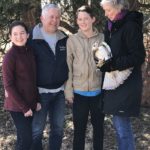
Dimmer family with Nikki and hawk
After a few family pictures and with the hawk in a box, “Miss Nikki” coaxed the Red-Tailed Hawk from his cardboard carrier and invited him to see again the park and his home. With a count of one, two and three, she encouraged him into the air and off he flew. He paused for a moment at the top of an oak tree before taking off across the park.
Three cheers for the Red-Tailed Hawk, for lessons learned and for good deeds done!
We have a RARE chance to help out: The Raptor Advocacy Rehabilitation & Education (RARE) is based out of Iowa City and is a 501c3 organization. For more information please visit their website at www.theraregroup.org
Photo Journey of Release
-
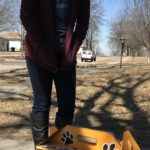
-
Ava by carrier.
-
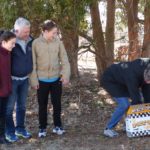
-
The Dimmer family watches as Nikki brings hawk out of the carrier.
-
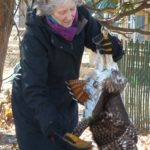
-
Hawk out of box
-
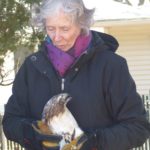
-
Woman hold hawk
-
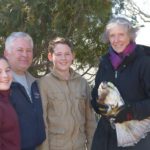
-
Ava, Todd, Kael, “Miss Nikki” and hawk.
-
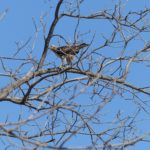
-
Hawk in tree
by Winding Pathways | Mar 8, 2017 | Children/Play, Wonderment
This blog from Community Playthings caught the eye of Winding Pathways. Indeed, today’s society is too concerned with correctness, cleanliness, and convention. A Buddhist saying goes something like this: spend twenty minutes outside everyday. If you think you are busy, spend an hour. At Winding Pathways we find this to be true. No matter the weather we try to get outside to see the sun or stars or clouds; to experience the wind or cold or heat; to feel the rain or snow on us. We keep our bearings, feel the roughness and gentleness of the environment and learn. Observe the changes of the seasons, find your Cardinal Points using the sun and structures, listen for the birds, watch the sky. Be. Above all, let kids be kids to slop around, spin, jump, tumble, get filthy dirty and then enjoy a warm bath and fresh clothes with a cup of hot chocolate and conversation. Go Outside and Play!
by Winding Pathways | Jan 20, 2017 | Amphibians/Reptiles, Children/Play, Nature, Wonderment
Almost all substances contract as they get colder. There’s one notable exception and it enables life.

Ice expands and floats
As water cools, it gets denser. As the temperature continues to drop, cold surface water sinks to the bottom. When the lake’s surface water reaches 39 degrees Fahrenheit something amazing happens. As weather continues to get colder it expands. When it turns to ice it expands even more! That’s why ice floats. If it didn’t, ponds and lakes would completely freeze and nothing could live in a solid block of ice.
Ice floating on a lake moderates the temperature of the water beneath it. Although the air temperature may be below zero above the ice the water beneath it is never below freezing. That’s why fish, frogs, and other aquatic organisms can not only live but also bask in the relative warmth of the water while terrestrial animals are forced to survive in arctic cold.
This phenomenon makes ice fishing possible. The following blog was written by a friend who took her children fishing one cold morning.
Ice Fishing With Kids
Story and photos of people
by: Kelly Carr
“They weren’t budging. Even with the overhead light flipped on, gentle shoulder shakes, and promises of the fun they would have, my kids feigned sleep. It was 7:00 a.m. on New Year’s Eve, and it had been about a year since our last ice fishing attempt. This particular day was the sixth of a seven day stretch of the new shared-custody arrangement I had with my daughter and son’s father. As if putting them through a divorce wasn’t guilt-inducing enough, now I was trying to drag them out of the security of their warm beds. My mind drifted back to the present – if I could just get them going, I knew they would have a great time. So, I played the “Let’s Get Donuts On The Way” card. Sleeping forms shifted, eyelids sprung open. We were out the door in fifteen minutes, teeth unbrushed, bedhead tucked under stocking caps, and feet snuggled into a double layer of socks.”
Donut Bribery works!
“I’ve tried to raise kids who feel comfortable in nature. Driving to the park for the ice fishing clinic, the car filled with the smell of maple frosting. I mused silently upon some of our past outdoor adventures. We have been geocaching newbies, tramping at a roadside park, looking for a “small bison container”, which, as it turned out, was NOT a buffalo figurine after all! We’ve packed picnics into cemeteries, and talked oaks and stones and stories while we ate.
“A voice from behind jostled me back to the present. I passed a cappuccino to waiting hands in the backseat and then pointed up to a hillside, “Look – a cemetery!” My daughter protested, “Not today, Mom! Ugh!” You win some, you lose some.
The Outdoor Thing
“We wound through the park to the shore. After a quick presentation by a naturalist and distribution of fishing guides, bait and poles, we were set. My kids chose spots not too far away from their last year’s spots, got settled in on mats and sipped from their gas station cups while waiting for spring-bobbers to bob. The sun made things sparkle, and as I looked at them handling things and sitting in peace, I knew I had nothing to feel guilty about. Tummies full, bundled in warm layers, taking a chance on adventure, we were doing this “outdoors thing”. And we were finding our new “normal” while doing it. They each pulled two fish out of the water that morning before asking to go back to the car to listen to music. I consider that as success.
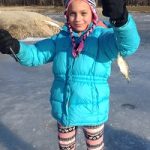
Smiles
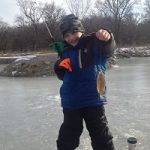
A warm bed is no match for the coolness of catching a panfish in winter.
“I had a few moments to myself out on the ice, to take it all in. Even when life changes, there are constants we can count on. The fish may not always bite, but while the sky is above and the earth (or ice) is below, I am a mother who loves her kids.”
by Winding Pathways | Jan 7, 2017 | Children/Play, Nature, Wonderment
Here is a great link to Community Playthings an organization that encourages families, grandparents and kids to do cool activities outside all year! Read their blog “Bundle Up and Get Outside.”
Winding Pathways will soon a feature a guest blogger’s adventures with her kids outside ice fishing.
























